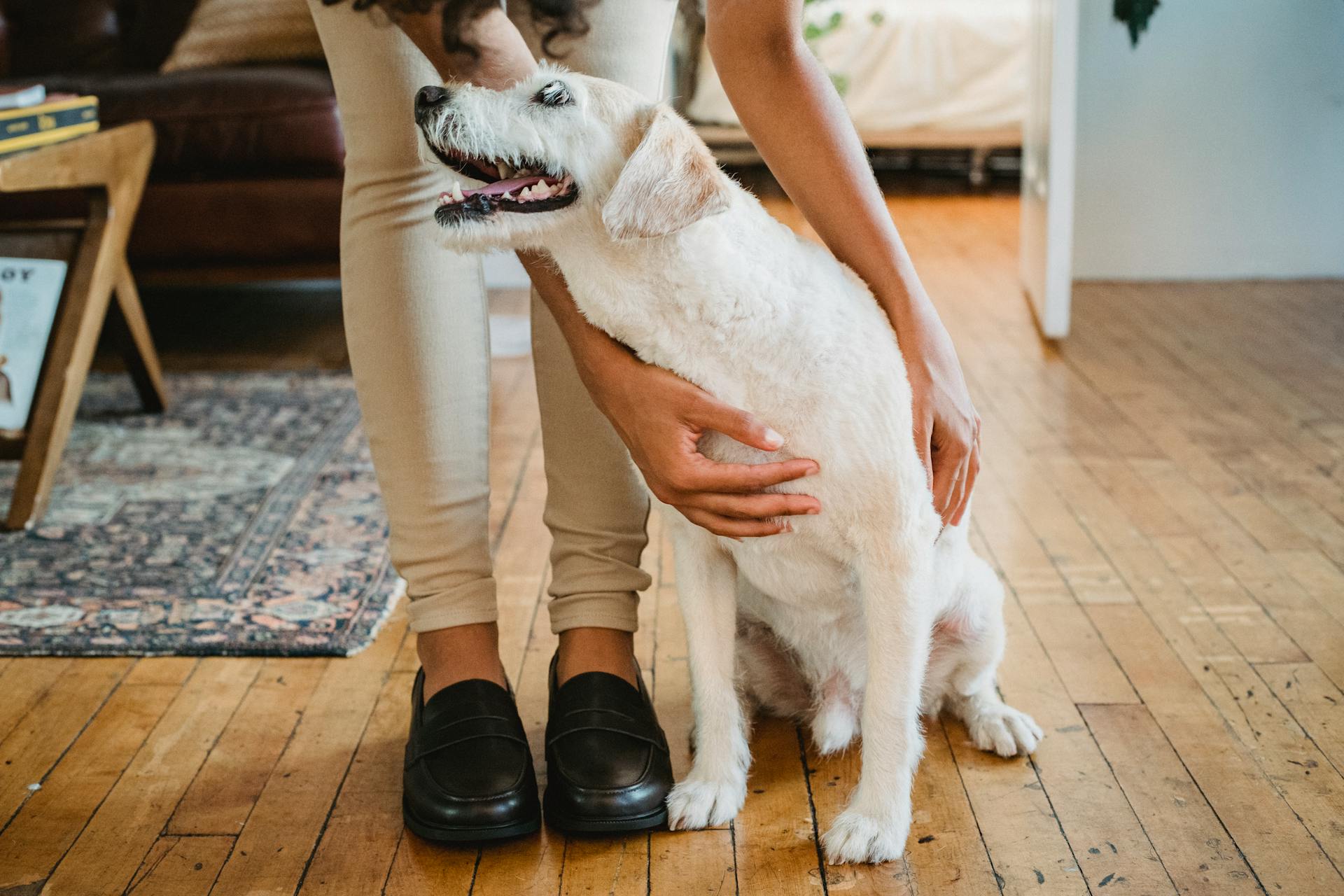
Female dogs typically reach physical maturity between 1-2 years of age, with some breeds taking longer to develop fully.
Their growth rate is influenced by factors such as breed, size, and nutrition, with larger breeds taking longer to mature.
A female dog's reproductive system usually reaches maturity between 6-12 months of age, but it's essential to wait until she's physically mature before breeding.
This ensures she's ready for the rigors of pregnancy and childbirth, which can be a significant strain on her body.
A different take: How to Tell the Age of a Female Dog
Stages of Growth
A female dog's growth stages can be a bit tricky to navigate, but understanding them is key to providing the right care at each stage. Puppies experience the fastest growth in their first six months, and most puppies will have reached 60% of their adult height by the time they are four months old.
Their skeletal growth happens first, and when this stage is complete, your dog will stop getting bigger. Then, your pup will fill out and continue to develop muscle and fat over time – just like humans.
Worth a look: Uniqe Girl Dog Names
Puppies will continue to develop and mature at different rates, and some breeds like Border Collies and other herding dogs don't typically mature and stop behaving like puppies until they reach the age of about two years old.
A good way to determine when your puppy has become an adult is to pay attention to their behavior. If your pet happens to stop their immature, hyperactive, or destructive behavior on their own, it's a safe bet that adulthood isn't too far off.
Here's a rough breakdown of the growth stages in dogs:
Keep in mind that these are general guidelines, and the timing of growth stages can vary depending on breed and size.
Factors Influencing Growth
Breed standards give us a good idea of a dog's expected size, but genetics play a bigger role in determining the final size of a dog.
Purebred standards can give us a range of weights and heights for a specific breed, but genetics tell us more about the dog's size and potential.
Curious to learn more? Check out: Dog Names Female Start with S
Genetics can also tell us how big or small the parents were, what the other puppies in the litter grew to, and more.
Males tend to be larger than females, so if you have a female pup, expect her to be on the lower end of the spectrum for her breed if she's a purebred.
Large breeds take almost twice as long to reach adult size than small dogs, with some needing up to 2 years to fully grow.
Here's a breakdown of the growth rates for different size dogs:
Physical Signs of Maturity
A female dog is fully grown when she reaches physical maturity, which can be identified by several key signs.
Physical changes are the most obvious indicators that a female Golden Retriever has reached maturity, and these signs typically occur around the age of 2.
Stable size and weight are a clear sign that a female Golden Retriever has reached physical maturity, as growth in height ceases and weight stabilizes.
A different take: Sudden Weight Gain in Female Dog
Developed musculature is another indicator of maturity, with mature Golden Retrievers having a well-developed musculature distinct from the more rounded, puppy-like appearance.
A full coat is also a sign of maturity, as the coat of a mature Golden Retriever will be fully developed, often thicker and more lustrous than during their puppy and adolescent stages.
The bones, particularly in the chest and skull, will be fully formed, giving the dog a more 'adult' appearance compared to the softer features of a puppy or adolescent.
Here are the physical indicators of maturity in a female Golden Retriever:
- Stable size and weight
- Developed musculature
- Full coat
- Bone structure fully formed
Keep in mind that even when bones are fully developed, a female Golden Retriever will continue to develop fat and muscle, so it's essential to monitor their growth and adjust their care accordingly.
Age and Maturity
A female dog's growth is a remarkable process, and understanding when she's fully grown can make a big difference in her care and well-being.
Most Golden Retrievers will have reached their full height by the age of one year, although they may continue to fill out and gain muscle tone.
The period between 18 to 24 months is crucial, as this is when most Golden Retrievers will have completed their growth in terms of height and size.
Here's a rough guide to what you can expect during this time:
Physical changes are also a clear indicator of maturity.
Breed-Specific Information
If you're wondering about the growth rate of female Golden Retrievers, it's essential to consider their genetic makeup. Genetics play a pivotal role in determining their size and growth rate, which can vary depending on their breed lines.
Breed lines, such as show lines and field lines, can have different growth rates and adult sizes. Show lines tend to be stockier and grow at a slower pace, while field lines are leaner and more agile.
The size of a Golden Retriever's parents is also a good indicator of their adult size. Generally, puppies from larger parents tend to grow larger, while those from smaller parents may remain comparatively petite.
Suggestion: When Do Puppies Grow Out of Zoomies

Here's a brief comparison of the expected growth patterns of Golden Retrievers based on breed lines:
- Show lines: Stockier, slower growth, and larger adult size
- Field lines: Leaner, faster growth, and smaller adult size
Understanding breed standards can also provide insights into expected growth. The American Kennel Club (AKC) outlines standard sizes for Golden Retrievers, which can serve as a reference for expected growth patterns.
Genetics and Breed Standards
Genetics play a significant role in determining the size and growth rate of Golden Retrievers. The genetic makeup inherited from their parents significantly influences their physical characteristics.
Different lines of Golden Retrievers, such as show lines and field lines, can have varying growth rates and adult sizes. Show lines tend to be stockier and may grow at a slower pace, while field lines are often leaner and more agile.
The size of a Golden Retriever's parents is a good indicator of their own adult size. Puppies from larger parents tend to grow larger, while those from smaller parents may remain comparatively petite.
Here are some key differences between show lines and field lines:
- Show lines: Stockier, slower growth rate
- Field lines: Leaner, faster growth rate
Small Breeds

Small breeds are known for their rapid growth, reaching their full-grown size between six and eight months old. This growth phase is crucial, so it's essential to provide them with the right dog food.
Pugs, Chihuahuas, and Boston Terriers are just a few examples of small breed puppies. They typically fill out to their healthy average weight by 12 months old, thanks to a diet tailored to support their development.
Here are some specific small breeds and their growth patterns:
- Pugs
- Chihuahuas
- Boston Terriers
Bernese Mountain Dog Puppy
Bernese Mountain Dog puppies are known for their slow maturation process. They typically don't reach their adult height and weight until they are 2 or 3 years old.
During the first year to 18 months of age, Bernese Mountain Dog puppies often look gangly, leggy, or unbalanced, and gawky. Their skeletons may grow unevenly, and their rear end may be an inch or 2 higher than their front end at certain times during development.
Explore further: Bernese Mountain Dog Male
It's essential to be patient and remember that people also look different at 30 or 40 years old than they did at 12, 16, or 20. A growing puppy's rear end may be an inch or 2 higher than the front end at certain times during development.
Bernese Mountain Dogs are slow maturing dogs, and most of them don't reach their adult height and weight until they are 2 or 3 years old.
Suggestion: 6 Month Old Shih Tzu Behavior
Differences in Male Golden Retrievers
Male Golden Retrievers tend to be larger and heavier than their female counterparts, with a more robust frame and greater stature.
They often continue to grow in size for a slightly longer period, reaching their full size later than females.
Females may mature slightly faster than males, both physically and mentally, which can impact training and socialization approaches during their growth phases.
Here's a comparison of male and female Golden Retriever growth patterns:
Health and Care

Regular health check-ups are crucial for monitoring a Golden Retriever's growth and overall health, allowing for early detection of potential issues. Regular check-ups can help in early detection of potential health issues, which is vital for addressing any growth-related problems.
A well-balanced diet is essential for a Golden Retriever's growth, with puppies requiring more protein and specific nutrients to support their rapid development. A diet that is well-balanced and tailored to the growth needs of Golden Retrievers is essential.
Regular flea and tick control is important for their overall well-being, as it can help prevent health issues that can impact growth. Keeping up with vaccinations and preventive care is important for their overall well-being.
Adequate exercise is important for muscle development and overall health, but should be balanced with rest, especially during the rapid growth phases to avoid stress on developing bones and joints. Exercise should be balanced with rest.
Regular veterinary check-ups can help determine the best time for spaying or neutering, which can have implications on growth and development. Discussing spaying or neutering with your vet is essential.
Take a look at this: Side Effects of Neutering a Female Dog
Frequently Asked Questions
How much bigger will a 6 month old puppy get?
At 6 months old, a puppy's growth rate varies by breed, but most will continue to grow significantly, with larger breeds still having ⅓ to ½ of their adult weight to gain. Check the specific growth chart for your puppy's breed to estimate their adult size.
Sources
- https://iandloveandyou.com/blogs/pet-blog/puppy-growth-chart-and-stages
- https://www.dogster.com/lifestyle/when-do-puppies-stop-growing
- https://www.mygoldenretrieverpuppies.com/blog/when-do-golden-retrievers-stop-growing
- http://www.bmdinfo.org/bernerpedia/Bernese_Mountain_Dog_Puppy_Growth.php
- https://www.akc.org/expert-advice/health/sexual-maturity-in-puppies-what-to-expect/
Featured Images: pexels.com


